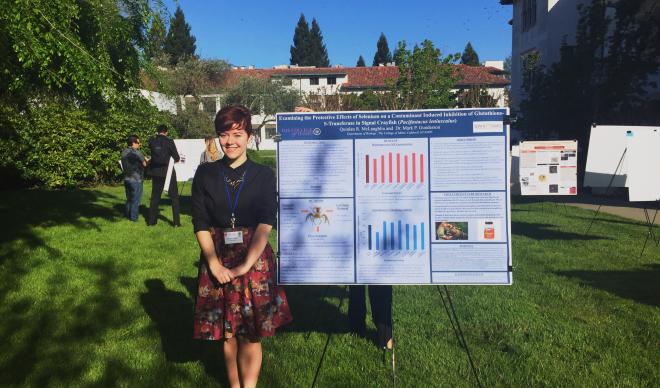
When C of I biology and art double major Quin McLaughlin’s name was called as the 1st Place winner for poster presentation in the Marine and Aquatic Biology category at the 43rd Annual West Coast Biological Sciences Undergraduate Research Conference earlier this month, she was so surprised by the recognition that she lost her shoes en route to accepting her award.
“I was just so shocked and excited that I had won,” McLaughlin said. “That day, I was just glad that people who saw my poster were excited about my research. It was nice seeing that excitement from other people, and I’m glad people think it’s as cool as I do.”
McLaughlin had spent the last year as a member of C of I biology associate professor Dr. Mark Gunderson’s lab preparing her biology honor’s thesis, a project which focused on the lab’s development of signal crayfish as model organisms to study environmental toxicology. The research lab was supported by an Institutional Development Award (IDeA) from the National Institute of General Medical Sciences of the National Institutes of Health under Grant #P20GM103408, one of several C of I projects supported by Idaho’s IDeA Network of Biomedical Research Excellence (INBRE).
McLaughlin’s research focused on the inhibition of the protein Glutathione S-transferase (GST) in signal crayfish, a detoxification enzyme that acts as the crayfish’s immune system when coming across toxifying chemicals like those found in pesticides and mining waste.
“A pattern we’ve seen with that enzyme is that when we expose the crayfish to metals and pesticides, it gets inhibited,” McLaughlin explained. “We think it gets inhibited because of the generation of reactive oxygen species that are reacting in response and causing a lot of cellular damage.”
McLaughlin’s thesis concentrated on the use of selenium exposure to counteract the decrease in GST activity, using selenium’s antioxidant properties in an attempt to reverse GST inhibition. McLaughlin designed and ran the experiments on her own, although she received assistance from lab mates in dissecting her crayfish specimens and running assays.
In the meantime, McLaughlin was also preparing artwork to participate in the 2018 Senior Art Exhibition, which portrayed flora and fauna featuring geometric figures and lines.
“It was a stressful time trying to organize work for both of my majors,” McLaughlin said. “There would be times I would need to neglect my art thesis so I could spend time in the lab. But being able to have my art to work on as well is a really, really good stress release for me. It’s a really Zen and relaxing thing to do.”
McLaughlin traveled to the April 14 conference at St. Mary’s College of California in Moraga alongside fellow members of Gunderson’s lab, Courtney Kelly and Isabela Lete, who were also presenting research at the conference. McLaughlin was the sole C of I representative to earn top honors in her category.
“I was a little nervous in California,” McLaughlin said. “This was a conference with more than just Idaho schools, and there was a lot of really great research being presented. It felt really prestigious, and a bit more intimidating.”
The added competition made McLaughlin even more proud to have received recognition for her research, which she also presented at the College’s Student Research Conference on April 28 — alongside her art exhibition. As someone who hopes to pursue graduate level research following her graduation from C of I, it was the best of both worlds.
“It’s really cool that I can show these two projects I’ve been working on for so long,” McLaughlin said. “I really enjoy research because there’s a lot of room for creative thinking when you form your own hypothesis and test your explanations. It ties great into being an artist, as well.”
The College of Idaho has a 127-year-old legacy of excellence. The C of I is known for its outstanding academic programs, winning athletics tradition and history of producing successful graduates, including seven Rhodes Scholars, three governors and countless business leaders and innovators. Its distinctive PEAK Curriculum challenges students to attain competency in the four knowledge peaks of humanities, natural sciences, social sciences and a professional field—empowering them to earn a major and three minors in four years. The College’s close-knit, residential campus is located in Caldwell, where its proximity both to Boise and to the world-class outdoor activities of southwest Idaho’s mountains and rivers offers unique opportunities for learning beyond the classroom. For more information, visit www.collegeofidaho.edu.